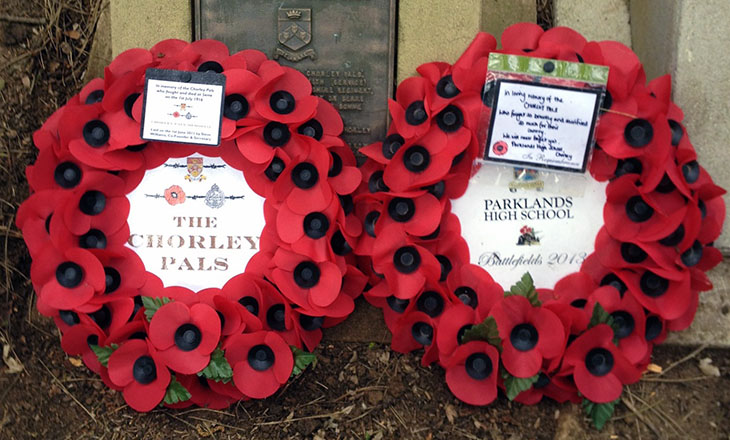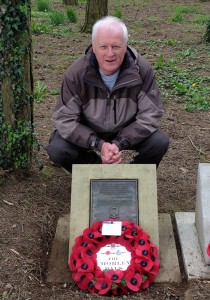
My first visit to the battlefields in France and Belgium was in 1992 when I took my father back to the beaches of Dunkirk he escaped from in early June 1940.
It would be another ten years, in 2002, before I returned – I have been going ever since, and lost count of the times I been to the Somme, Ypres, Dunkirk, Dieppe, Normandy, Arnhem, Bastogne…. the list goes on.
Last week I was on the Somme laying a wreath at the Chorley Pals plaque in the front line trenches at Serre where the Pals attacked on the morning of the 1st July 1916.
I was pleased to see that pupils from Parklands High School had been there recently. A school party from Hampshire were there as well and a few stopped to chat. “Yes”, they said, “we know all about the Chorley Pals, they were part of the Accrington Pals; we’ve been on your website”.
 That last comment about the Internet brought things home to me.
That last comment about the Internet brought things home to me.
There was I taking a picture of the wreath with my iPhone, ready to put it on Facebook and Twitter for the whole world to see.
On the same device (with far greater computer power than the one in Apollo 11 that landed men on the moon), I can photograph, communicate, find out the weather, see maps, access my bank account, listen to music and even use it as a torch.
I began to wonder what the Pals would have made of such a small device? Communication on the battlefield was down more to men acting as “Runners” than telephone or morse lamp – what would they have done with texts, I thought?
Also, it took over a week for details of the casualties to come from the Somme in July 1916 – they began to be published on a noticeboard in Chorley Town Hall and a week later in the Chorley Guardian; would the families wished to have received information from the battlefield almost in real-time?
After the Pals trenches, my wife and I had a trip around the Somme and Cambrai battlefields, before heading off to ‘Le P’tit train de la Haute Somme’ - a preserved, narrow-gauge railway that transported men and materiel back in 1916. A visit to Claude Monet’s garden at Giverney was well worth the trip, before we headed for a few days in Rouen where, ironically, the British burnt Joan of Arc at the stake in May 1431.
A day was spent on the Channel coast at Fecamp and Etretat. At the former, I wandered around the remnants of Hitler’s “Atlantic Wall” from 1944, before heading to Etretat to lay a poppy cross on the grave of Chorley Pal, Private James Makinson. He was wounded on the Somme on the 1st July 1916 and died of his wounds eight days later at a hospital at Etretat.
In the parish church can be found a large plaque to the men from the town who fell in service of their country - underneath it included the phrase “et des soldats de l’Armee Britannique inhumes dans le cimetiere”, remembering also the men from the British Army buried in the cemetery.
Made me think a bit about the debate on Europe – as did a pleasant chat to a German gentleman at breakfast the following morning who was born in 1946 (I didn’t ask, but his father probably fought mine in the War).
Is it worth going to the Somme or Normandy when we have Facebook, Google Earth and YouTube?
Well, for me, there is no substitute for standing where Chorley men fought and died, and paying my own respects – their sacrifice enabled me the freedom to be there, as well as share it via Facebook (thanks to them and all those who “followed me”).



